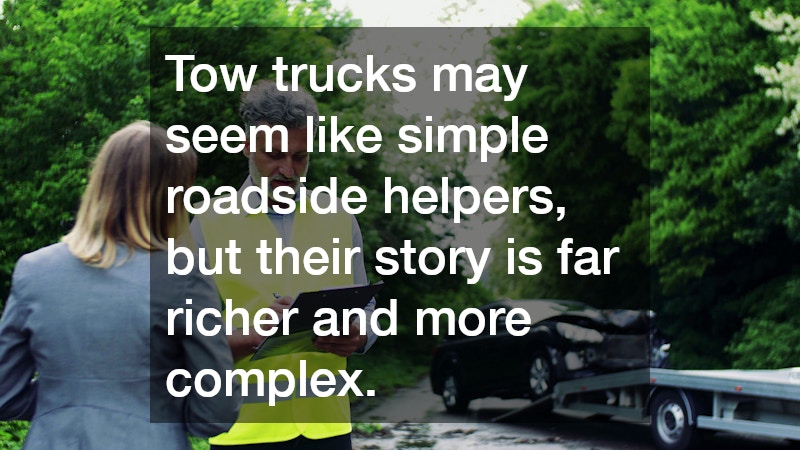5 Things You Didnt Know About Tow Trucks

Tow trucks are a common sight on our roads, yet most people only think of them when they are stranded with a flat tire, a dead battery, or after an accident. While they are often viewed simply as roadside rescue vehicles, tow trucks have a fascinating history, a variety of designs, and impressive capabilities that make them essential for drivers and communities alike. This article uncovers five things you probably didn’t know about tow trucks, from the different types and technologies they use to the legal requirements that govern them and their surprising role in culture and history.
1. What Are the Different Types of Tow Trucks?
Flatbed Tow Trucks
Flatbed tow trucks are among the most common types you’ll see on the road today. They feature a long, flat platform that can be hydraulically inclined and lowered to ground level. Vehicles are driven or pulled onto the platform, making them secure for transport. These trucks are ideal for damaged cars, all-wheel drive vehicles, and even heavy machinery, since they reduce the risk of further wear or damage during towing.
Hook and Chain Tow Trucks
The traditional hook and chain tow truck, once the industry standard, uses a large hook to attach to the vehicle’s frame or axle and chains to secure it. While effective, this method often caused damage to the vehicle’s body and suspension, which is why it has been largely phased out for passenger cars. Today, hook and chain trucks are still useful for towing junk vehicles to scrap yards or moving wrecked cars that are no longer roadworthy.
2. How Do Tow Trucks Operate in Different Situations?
Emergency Roadside Assistance
Tow trucks are often the first responders in vehicle breakdowns or accidents. Dispatch systems ensure they can be sent quickly to the scene, whether it’s to jump-start a battery, change a flat tire, or remove a car from a collision site. Their quick arrival often helps keep traffic moving and roads safe.
Vehicle Recovery from Less Accessible Areas
It’s not just highways where tow trucks do their work. Skilled operators often recover vehicles stuck in ditches, mud, snow, or even bodies of water. Specialized winches and recovery techniques allow tow trucks to pull vehicles out of places that seem nearly impossible to reach.
3. What Are the Latest Technological Advances in Tow Trucks?
GPS Tracking and Dispatch Systems
Modern tow trucks are equipped with GPS tracking and advanced dispatch software. These systems allow dispatchers to send the closest available truck to a stranded driver, reducing response times and improving customer service.
Hydraulic Lift and Towing Mechanisms
Hydraulic systems have revolutionized the towing industry. They provide smooth lifting and precise control, enabling operators to tow vehicles more safely and efficiently. Whether it’s a flatbed tilting mechanism or a hydraulic boom, this technology has made towing faster and more reliable.
4. What Are the Legal Requirements for Tow Truck Operators?
Licensing and Certification
Tow truck operators must obtain specific licenses and, in some regions, additional certifications to operate legally. Training programs cover safety, vehicle recovery techniques, and customer service, ensuring operators are prepared for various challenges.
Legal Obligations and Safety Standards
Tow companies are subject to strict safety standards, from how vehicles are secured to proper use of warning lights. Operators must follow both state and federal regulations to keep roads safe and protect the vehicles they transport.
Consequences of Violating Regulations
Failure to comply with legal requirements can result in fines, suspension of licenses, or even the shutdown of a business. These rules not only protect drivers but also ensure professionalism and accountability within the industry.
5. How Has the Role of Tow Trucks Evolved Over Time?
Historical Background and Early Models
The tow truck was invented in 1916 in Chattanooga, Tennessee, when Ernest Holmes Sr. developed a modified car equipped with pulleys and a crane to help recover stranded vehicles. This invention marked the birth of the towing industry.
Changes in Design and Functionality
Over the decades, tow trucks have evolved dramatically. From the basic hook-and-chain models to today’s sophisticated hydraulic flatbeds and integrated trucks, each advancement has improved safety, efficiency, and versatility.
Tow Trucks in Popular Culture
Tow trucks have also made their mark in popular culture, most notably in animated films and television shows where they are often portrayed as helpful, quirky, or even heroic. These portrayals highlight their importance beyond the practical, embedding them in the public’s imagination.
Tow trucks may seem like simple roadside helpers, but their story is far richer and more complex. From the variety of types and their unique functions to the advanced technologies that make them efficient and eco-friendly, tow trucks are indispensable vehicles that continue to evolve. Their role extends beyond emergencies—they are part of road safety, history, and even culture. By understanding more about tow trucks, we can better appreciate the essential services they provide and the skilled operators who run them.



